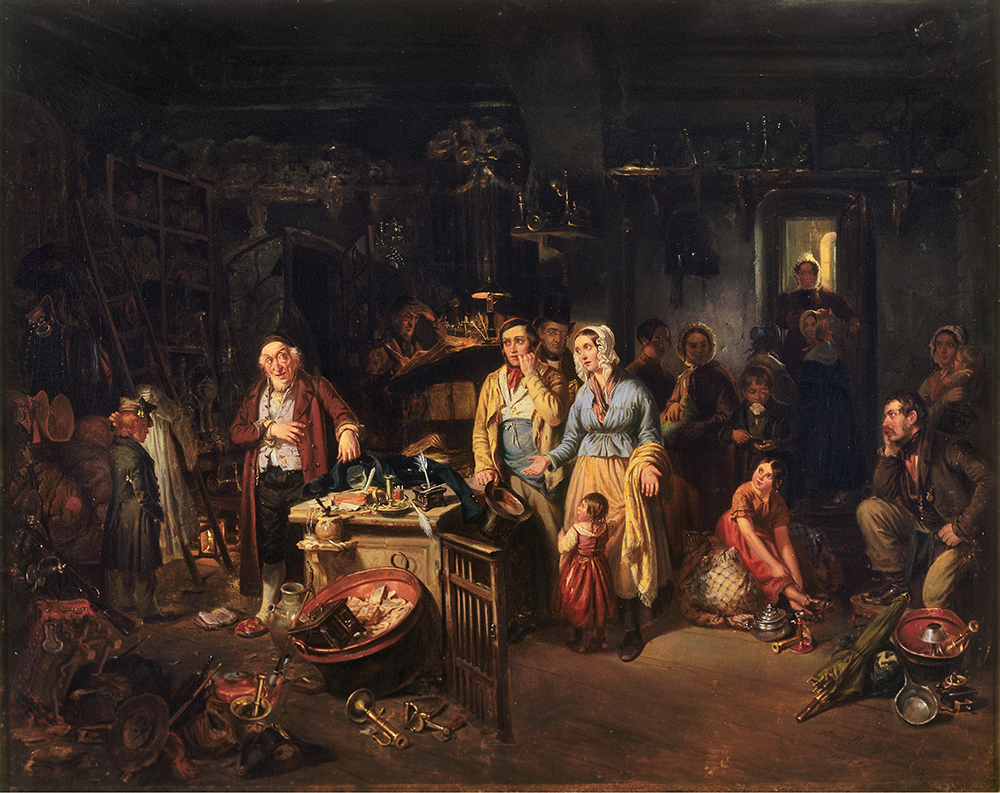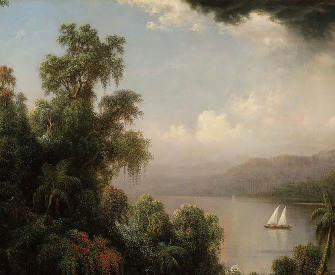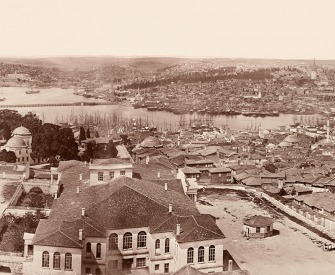The human working stock is of interest only insofar as it is profitable.
—Simone de Beauvoir, 1970Post Route
Francis Parkman attempts a trade.
Looking back after the expiration of a year upon Fort Laramie and its inmates, they seem less like a reality than like some fanciful picture of the olden time, so different was the scene from any which this tamer side of the world can present.
Tall Indians, enveloped in their white buffalo robes, were striding across the area or reclining at full length on the low roofs of the buildings which enclosed it. Numerous squaws, gaily bedizened, sat grouped in front of the rooms they occupied; their mongrel offspring, restless and vociferous, rambled in every direction through the fort; and the trappers, traders, and engagés of the establishment were busy at their labor or their amusements.
We were met at the gate, but by no means cordially welcomed. Indeed, we seemed objects of some distrust and suspicion, until Henry Chatillon explained that we were not traders, and we, in confirmation, handed to the bourgeois a letter of introduction from his principals. He took it, turned it upside down, and tried hard to read it; but his literary attainments not being adequate to the task, he applied for relief to the clerk, a sleek, smiling Frenchman named Monthalon. The letter read, Bordeaux, the bourgeois, seemed gradually to awaken to a sense of what was expected of him. Though not deficient in hospitable intentions, he was wholly unaccustomed to act as master of ceremonies. Discarding all formalities of reception, he did not honor us with a single word but walked swiftly across the area, while we followed in some admiration to a railing and a flight of steps opposite the entrance. He signed to us that we had better fasten our horses to the railing; then he walked up the steps, tramped along a rude balcony and, kicking open a door, displayed a large room, rather more elaborately finished than a barn. For furniture it had a rough bedstead (but no bed), two chairs, a chest of drawers, a tin pail to hold water, and a board to cut tobacco upon.
This apartment, the best in Fort Laramie, was that usually occupied by the legitimate bourgeois, Papin, in whose absence the command devolved upon Bordeaux. The latter, a stout, bluff little fellow, much inflated by a sense of his new authority, began to roar for buffalo robes. These being brought and spread upon the floor formed our beds, much better ones than we had of late been accustomed to. Our arrangements made, we stepped out to the balcony to take a more leisurely survey of the long looked-for haven at which we had arrived at last. Beneath us was the square area surrounded by little rooms, or rather cells, which opened upon it. These were devoted to various purposes but served chiefly for the accommodation of the men employed at the fort, or of the equally numerous squaws whom they were allowed to maintain in it. Opposite to us rose the blockhouse above the gateway; it was adorned with a figure of a horse at full speed, daubed upon the boards with red paint, and exhibiting a degree of skill which might rival that displayed by the Indians in executing similar designs upon their robes and lodges. A busy scene was enacting in the area. The wagons of Vaskiss, an old trader, were about to set out for a remote post in the mountains, and the Canadians were going through their preparations with all possible bustle, while here and there an Indian stood looking on with imperturbable gravity.
Fort Laramie is one of the posts established by the American Fur Company, which well-nigh monopolizes the Indian trade of this region. Here its officials rule with an absolute sway; the arm of the United States has little force; for when we were there, the extreme outposts of her troops were about seven hundred miles eastward. The little fort is built of bricks dried in the sun and externally is of an oblong form, with bastions of clay, in the form of ordinary blockhouses, at two of the corners. The walls are about fifteen feet high and surmounted by a slender palisade. The roofs of the apartments within, which are built close against the walls, serve the purpose of a banquette. Within, the fort is divided by a partition; on one side is the square area, surrounded by the storerooms, offices, and apartments of the inmates; on the other is the corral, a narrow place, encompassed by the high clay walls, where at night, or in presence of dangerous Indians, the horses and mules of the fort are crowded for safekeeping. The main entrance has two gates, with an arched passage intervening. A little square window, high above the ground, opens laterally from an adjoining chamber into this passage, so that when the inner gate is closed and barred, a person without may still hold communication with those within through this narrow aperture. This obviates the necessity of admitting suspicious Indians, for purposes of trading, into the body of the fort; for when danger is apprehended, the inner gate is shut fast, and all traffic is carried on by means of the window. This precaution, though necessary at some of the company’s posts, is now seldom resorted to at Fort Laramie, where, though men are frequently killed in the neighborhood, no apprehensions are felt of any general designs of hostility from the Indians.
We were sitting, on the following morning, in the passageway between the gates, conversing with the traders Vaskiss and May. These two men, together with our sleek friend, the clerk Montalon, were, I believe, the only persons then in the fort who could read and write. May was telling a curious story about the traveler Catlin, when an ugly, diminutive Indian, wretchedly mounted, came up at a gallop and rode by us into the fort. On being questioned, he said that Smoke’s village was close at hand. Accordingly, only a few minutes elapsed before the hills beyond the river were covered with a disorderly swarm of savages on horseback and on foot. May finished his story, and by that time the whole array had descended to Laramie Creek and begun to cross it in a mass. I walked down to the bank. The stream is wide and was then between three and four feet deep, with a very swift current. For several rods the water was alive with dogs, horses, and Indians. In a few moments the crowd melted away; each family, with its horses and equipage, filing off to the plain at the rear of the fort; and here, in the space of half an hour, arose sixty or seventy of their tapering lodges. Their horses were feeding by hundreds over the surrounding prairie, and their dogs were roaming everywhere. The fort was full of warriors, and the children were whooping and yelling incessantly under the walls.
These newcomers were scarcely arrived when Bordeaux ran across the fort, shouting to his squaw to bring him his spyglass. The obedient squaw, Marie, produced the instrument, and Bordeaux hurried with it to the wall. Pointing it eastward, he exclaimed with an oath that the families were coming. But a few minutes elapsed before the heavy caravan of the emigrant wagons could be seen, steadily advancing from the hills. They gained the river and, without turning or pausing, plunged in, passed through, and slowly ascending the opposing bank, kept directly on their way by the fort and the Indian village, until gaining a spot a quarter of a mile distant, they wheeled into a circle. For some time our tranquility was undisturbed. The emigrants were preparing their encampment; but no sooner was this accomplished than Fort Laramie was taken by storm. A crowd of broad-brimmed hats, thin visages, and staring eyes appeared suddenly at the gate. Tall, awkward men in brown homespun, women with cadaverous faces and long, lank figures, came thronging in together and, as if inspired by the very demon of curiosity, ransacked every nook and corner of the fort.

The Pawn Shop, by August von Rentzell, 1842. © bpk Bildagentur / Deutsches Historiches Museum, Berlin / Art Resource, NY.
Having at length satisfied their curiosity, they next proceeded to business. The men occupied themselves in procuring supplies for their onward journey, either buying them or giving in exchange superfluous articles of their own.
The emigrants felt a violent prejudice against the French Indians, as they called the trappers and traders. They thought, and with some reason, that these men bore them no goodwill. Many of them were firmly persuaded that the French were instigating the Indians to attack and cut them off.
A full share of suspicion fell upon us. Being strangers, we were looked upon as enemies. Having occasion for a supply of lead and a few other necessary articles, we used to go over to the emigrant camps to obtain them. After some hesitation, some dubious glances, and fumbling of the hands in the pockets, the terms would be agreed upon, the price tendered, and the emigrant would go off to bring the article in question. After waiting until our patience gave out, we would go in search of him, and find him seated on the tongue of his wagon.
“Well, stranger,” he would observe as he saw us approach, “I reckon I won’t trade.”
Some friend of his had followed him from the scene of the bargain and suggested in his ear that clearly we meant to cheat him, and he had better have nothing to do with us.

Francis Parkman
From The Oregon Trail. Established as a fur-trading post in 1834, Fort Laramie began operation toward the end of the beaver-pelt boom and served as an outpost for local native tribes and white settlers to conduct trade in buffalo hides. Parkman began his westward tour shortly after graduating from Harvard Law School and published this account in installments in The Knickerbocker magazine. Herman Melville praised the text’s “true wild-game flavor.” In 1849 the U.S. Army took over the fort and operated it until 1890.


